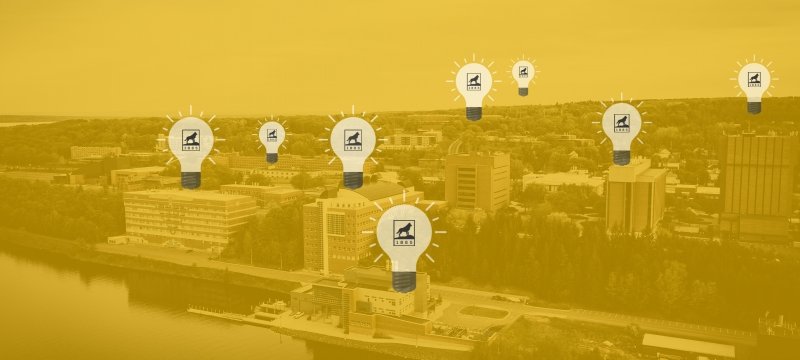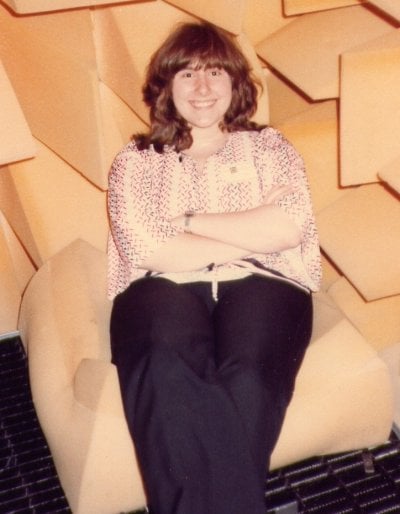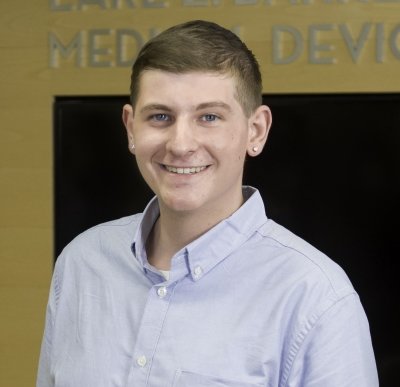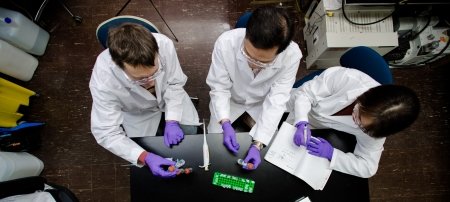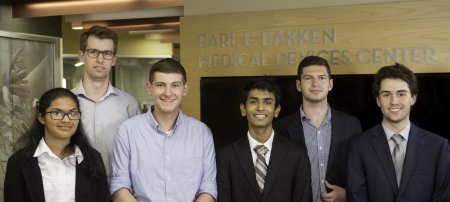Michigan Tech alumni share a propensity for patents.
Huskies become inventors at a higher rate than most college graduates, according to a nationwide study on universities whose alumni are most likely to file a patent. The study has some theories about why Michigan Tech ranks so highly on the inventor-nurturing scale. So do some of our most notable patent holders and experts whose boundless curiosity about how things work and drive to innovate continues to change the world for the better.
If these innovators are a mirror offering a glimpse into the highly effective habits of patent-holding Huskies, then the study is a telescope through which we can gaze to identify the future steps that will ensure innovation can diversify, expand, and defy existing boundaries.
Who Becomes an Inventor in America? Huskies do.
Michigan Tech is one of the 10 most innovative colleges in the United States, identified by patent rate.
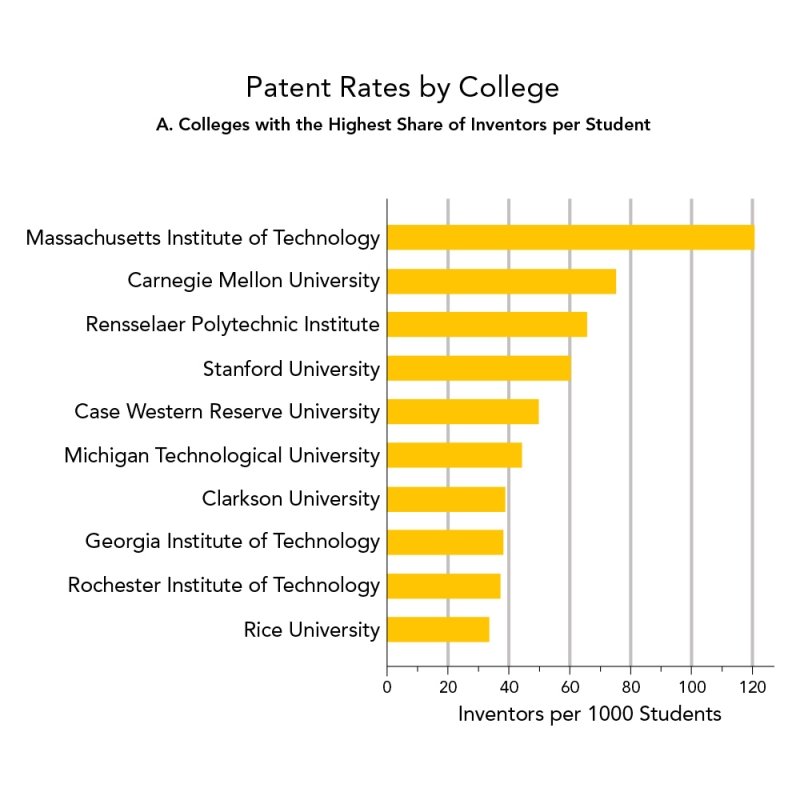
In the December 2017 study "Who Becomes an Inventor in America? The Importance of Exposure to Innovation," Michigan Tech ranks sixth among the top 10 universities in the nation whose alumni become inventors at the highest rates, determined by filings in the US Patent and Trademark Office (USPTO). Conducted by researchers from Harvard, Stanford University, the London School of Economics, the MIT Centre for Economic Performance, and the US Treasury Department Office of Tax Analysis, the study linked patent application and grant data between 1996 and 2014 to federal income tax returns, building a dataset of 1.2 million inventors.
While the findings are indicative of the quality of a Michigan Tech education and the accomplishments of its graduates, the thrust of the study points to the work that needs to be done, specifically speaking to the need for diversity, inclusion, and equity in order to expand the boundaries of innovation to find what the study authors call "the lost Einsteins."
For example, the authors note that kids from families in the top one percent income bracket are 10 times more likely to be inventors as children in families earning below-median income. White people are more than three times as likely to become inventors as Black people, while 82 percent of 40-year-old inventors are men.
"This gender gap in innovation is shrinking gradually over time, but at the current rate of convergence, it will take another 118 years to reach gender parity," the study authors write. "Putting these data together, we estimate that if women, minorities, and children from lower-income families were to invent at the same rate as white men from high-income (top-quintile) families, the total number of inventors in the economy would quadruple. "
The unique backgrounds and journeys of these innovative alumni—who hail from places near and far and include trailblazers who routinely step out of their comfort zones—may offer clues to finding the lost Einsteins.
Judy Swann BS '83: Expert in Patent Procurement
Meet an engineer who likes to write, loves to talk to inventors, and has routinely shattered preconceived notions for herself and others throughout her professional life. What Judy Swann calls "the most wonderful career I could have had" includes a lot of fascinating stories—and insights as deep and wide as the USPTO's legendary archival stacks before they were digitized.
The 1983 mechanical engineering graduate has seen—and reviewed—it all over a 34-year career as a patent examiner and supervisor with the USPTO, from amateur inventors working out of the family garage to professionally shepherded proposals from large corporations. There are some tales she can't share. A commitment to maintain confidentiality comes with the territory.
"We never talk about applications until they're issued as patents," says Swann. A member of the MTU Presidential Council of Alumnae (PCA), Swann has been recognized for her professional achievements by the USPTO as well as Michigan Tech, in the latter case for dedication to forward the University's strategic initiatives and mentoring up-and-coming professionals.
Becoming a patent examiner isn't a career most engineering majors consider. Swann didn't, until her roommate at MTU noticed she wasn't going to any job interviews and tossed her a patent office business card to get her moving (the USPTO still hires Huskies and it's safe to say that go-getting roommates are still pushing their more reluctant counterparts out the door for interviews).
"It requires a couple of skill sets: the engineering skill set along with research, reading, and writing—which I actually like as much as pure engineering," Swann says.
The Saginaw, Michigan, native started her USPTO career in 1983. "I was one of the first women in the hiring wave—I believe there were three or four of us out of a staff of 80 in my mechanical group. It was a truly pioneering experience in the engineering arena," she says. The start of her career would rapidly be followed by another remarkable wave: technological advancement at the USPTO.
"Back in the day before there were computers, we walked between multiple buildings to search in many spaces filled with filing cabinets," she says. "Patents would be filed in a primary technology area, but then copies would be placed in secondary areas. Like a bicycle patent may have a copy placed in a materials area if a particular tire or frame material was disclosed, or in methods if a new method of manufacturing was discussed. There were drawers and drawers of what we call 'shoes' full of old paper patents. Hours were spent looking through crumbly, dusty pieces of paper; people spent their entire days refiling these papers."

Adapting to new technology wasn't an issue for Swann. She's always been intrigued by how things worked. That's why she snapped up the opportunity to go to Tech. "I like doing a little bit of everything and I knew I would not be able to support myself with history or writing. I like taking things apart; I figured, 'Hey, get paid for taking things apart!'"
She also devised a way to pay for school early on. Swann's father was a high school co-op instructor, so she was familiar with the process. "I found a job at General Motors, and co-oped my senior year of high school and most of college," she says. "That made it affordable for me to go to Tech."
As her career progressed, Swann became a strong recruiter and a trainer for both her agency and her alma mater. "We have been hiring an amazing amount of graduates," she says. "It can be a very exciting career. You're looking at different applications, inventions, problems, and solutions all the time. It's kind of like detective work. It can be very fun. An examiner is always learning. We're as curious as the inventors. We like to get into that stuff."
There's only one downside, says Swann. "We have a limited amount of time to spend with an application. The biggest frustration is performing the best examination of the application with the time you have. It is a learning process to know when to stop searching prior art."
Swann worked in several different technologies in the office, including vehicles ("many things that move—aspects of cars, but also wheelchairs, skis, bicycles—you name it"), grinding machines ("not my forte"), electrical connectors, refrigeration, and cryogenics.
"I was not afraid to try. I was not afraid to learn because I was able to learn and I was confident. That was a gift from Michigan Tech," she says.
I don't know if I could have done this job as well coming from another school. Not only did I learn, I learned how to learn at Michigan Tech.

Get Patent Tips From a Pro on Michigan Tech Unscripted.
Why Huskies are Suited to Patents—and Patent Careers
"I used to lobby for hiring as many people from Michigan Tech as possible because the alumni are more logically minded," says Swann. "By and large the entire group of people that have graduated from this school are technically minded, certainly more logical than other universities that are not based in STEM."
"At the patent office we're not the average type of employees, either. To be readers, to be writers, to not work with our own devices but others'. That combination of skill sets is seriously unusual," she says. "On top of that we're asking those people to turn around 10–15 years into their careers and become managers, requiring a whole new set of skills."
When she became a supervisor, Swann shifted from work in one specific area, or docket, to assisting with administration of a broader range of proposed patents. The daughter of teachers, who had initially seen engineering as a way out of the family profession, instead found an affinity for training and mentoring. "I was blessed to work and teach all over the office," she says. "It's not your typical office, and not what people think of when they think of a government agency. We try to show the examiners the importance of the work they do."
"I love talking to inventors. Their excitement and enthusiasm about what they invented is contagious. It was marvelous to sit down with them, have them show their models, and talk. I could listen to that forever, it was so cool!"
To make things exciting for examiners she regularly reached out to individuals and firms to bring in demonstrations. The patent office regularly hosts technology fairs as well. One of the greatest rewards, Swann says, was continual exposure to new ideas and innovators. One of her first experiences was with the then-emerging line of Black & Decker products. She brought versions of the Segway and the Prius to USPTO for examiners to see before they were commercially available.
Agents as Advocates, Not Adversaries
The scenario of cutthroat business competitors racing to secure a billion-dollar patent isn't a reflection of the USPTO process itself, says Swann. "It is a process of trying to work with each inventor," she says. "Examiners have a duty. We provide knowledge in the form of published patents, to drive innovation, and to help people who are going to try to get patents. We're working with inventors who contribute to a body of research. Do they have something patentable? What is it, specifically? We want them to have nice, tight, clean patents that they can use to build their businesses."
How to Become a Prolific Inventor
No story on Michigan Tech alumni's propensity for patents is complete without a hats-off to Orhan Soykan MS Electrical Engineering '86 and his impressive tally: 37 issued and 66 patents pending.
A professor of practice in the Department of Biomedical Engineering, Soykan specializes in implantable devices, biosensors, and molecular medicine. He says anyone can be an inventor. "I believe necessity is the mother of all invention, " says Soykan. "You must truly understand the problem and the boundaries the solution will have." Find out more about his process (and meet his four-legged family members). You can also watch his talk on the College of Engineering's Husky Bites series for more insights and inspiration.
Aspirations and support are grounded in effort. The patent process requires rigorous attention to details and timelines on the part of applicants as well as agents. "Sometimes we have interviews. Sometimes it's patentable right off the bat," Swann says. "But it's unusual for a first submission to become a patent. There's usually some language that can be made more clear."
When the office receives applications, it bases its next steps on technology, clarity, and correctness of the submission. "We review anything that's out there in the same area—has it been done before?—then we write an opinion, an 'office action,' and the applicant is invited to comment about it," says Swann. "There can be a lot of back and forth."
Having stepped through doors that were only beginning to open when she entered the profession, Swann is a stalwart advocate for removing obstacles to achievement. Her preferred tools are mentorship and education.
In addition to her work with the Alumnae Council, Swann served as the first female president of the Patent and Trademark Office Society. Founded in 1917, it's the social and educational arm of the organization, says Swann. "Being president is one of my proudest and most fulfilling achievements. It's an excellent organization that judges local and national science fairs, publishes a highly regarded journal, and sponsors various lectures as well as wonderful social events. It's one of my favorite things about the USPTO."
After her career with USPTO, Swann worked as a patent agent with Oblon, McClelland, Maier & Neustadt LLP, a law firm specializing in intellectual property. She worked in the realm of what happens after a patent has been made as ironclad and clear as her former office could make it. "In a sense it was the next step of where my previous job left off," she says. "It was a natural progression." Swann recently retired to focus on her family—and she continues to serve as a Michigan Tech mentor and supporter.
"I really believe in the patent system. I tried to impress upon the people who worked for me the reason behind why we're doing this as public servants. Every application in front of you could be the foundation for someone's livelihood. It could start a business or an industry. You have no idea where it could go. You want it as good as it can be so they can fly as high and far as they want to. Livelihoods lift up the economy."
Hall of Famer Iver Anderson BS '75: Lead-free Solder Changed the World
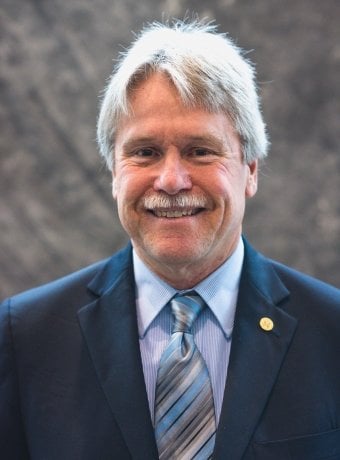
Taking innovation as far as it can go—and going farther still—is an apt assessment of the work of Iver Anderson. The alumnus, who hails from Hancock, has often reflected on how his Keweenaw upbringing shaped his curiosity and problem-solving abilities. He's best known for US Patent No. 5,527,628. Anyone who has a cell phone can relate to his invention; he literally took the lead out by inventing lead-free solder in 1992. His alloy, composed of tin, silver, and copper, is used in 70 percent of consumer electronics today. The 1975 metallurgical engineering graduate, who went on to earn his master's and PhD in the field at the University of Wisconsin-Madison, was inducted into the National Inventor Hall of Fame in 2017.
In a video about his work, Anderson says he was always driven to solve problems. Being told he can't do something spurs him on—and so does being first to put together an answer.
"My thesis advisor told me that it was impossible to develop a lead-free solder alloy in the system I was talking to him about using. I said, 'It's well worth looking at.' Just thinking about the problem, about what binary alloys do, really gives you insight about what a more complex alloy would do," says Anderson, a fall 2020 special guest on the Michigan Tech College of Engineering's family-friendly Husky Bites webinar. "There is no safe lead level. It makes me feel warm inside to have solved one problem that will help us going on into the future."
Through the work of Anderson and his team, many tons of lead have been diverted from the environment, which diminishes leaching into drinking water as well as other human exposure, including low-wage recyclers in Third World countries.
A senior metallurgist at Ames Laboratory and adjunct professor in materials science and engineering at Iowa State University, Anderson's work in powder metallurgy, metallurgical joining in electronic assembly, and associated applications has resulted in more than 265 publications and 45 patents.
"You have to discover what is the motivation you feel, and then follow it deep."
Research Engineer Venkata Rajesh Chundru MS '17 PhD '19: First Patent

Mechanical engineering-engineering mechanics alumnus Venkata Rajesh Chundru delves deep into modeling and control systems design of diesel aftertreatment systems, but also looks skyward for inspiration as he celebrates the milestone of securing his first patent, Patent No. 10690033, "After Systems and Methods for Treatment of Exhaust Gas from Diesel Engines," and moves future patents toward completion.
A research engineer specializing in advanced algorithms and powertrain controls at Southwest Research Institute (SwRI) in San Antonio, Texas, Chundru says continuous interaction and technical discussion with MTU faculty advisors Gordon Parker and John Johnson as well as long hours in the lab were critical to his success. So was nurturing his creativity by turning his camera on the Keweenaw. "My off-hours photography of stars and northern lights were a great inspiration," Chundru says. "It kind of encouraged me to think out of the box, which is one of the important qualities for coming up with new ideas."

Chundru says Michigan Tech is fertile ground for inventors. "The focus at Michigan Tech on good coursework curriculum combined with a practical approach to teaching in the labs such as APS (Advanced Power Systems Labs) play an important role in encouraging students like me to innovate."
Chundru draws further parallels between his postgrad work and his job at SwRI as he continues on his patent path. "My work focuses on aspects of diesel engines that are similar to this patent. As a result I have recently applied for a US patent on a similar control system with a third patent idea in development," he says. "They are still in the draft phase so I can't get into details. But I intend to keep developing such designs, control systems through patents and real-world demonstration programs."
See more of Chundru's process, progress, and photography in "Long Lab Nights, Northern Nights" on Michigan Tech Unscripted Science and Research Blog.
"No idea is too unrealistic. When we come up with a new idea it typically sounds infeasible—but that's the whole point. If it is obvious then it would have been out there already."
Jeremy Wales BS '21: Provisional Patent Application Pending
Biomedical engineering undergraduate Jeremy Wales has a provisional patent application pending related to a vascular medical device. The biomedical engineering undergraduate discovered his interest in innovation during a University of Minnesota project in summer 2019. The patent process was moving forward at the time of this publication, including a technical brief that was accepted to the 2020 Design of Medical Devices Conference. "At this time, we are in the process of filing for our provisional patent for the device, and hopefully within a year we may have something accepted," Wales says.
Wales was surprised by how satisfying working toward securing a patent can be. "It wasn't my initial plan to use my degree in the research and development side of the field," he says. "But after getting the experience and seeing what it takes, I definitely would like to have a few more under my belt someday."
Learn more about how Wales found and developed his inner innovator in his story on the Humans of Michigan Tech blog.
"Michigan Tech encourages its engineering students to not only understand how the things we make work, but to also think about how they could work better."
Michigan Technological University is an R1 public research university founded in 1885 in Houghton, and is home to nearly 7,500 students from more than 60 countries around the world. Consistently ranked among the best universities in the country for return on investment, Michigan's flagship technological university offers more than 185 undergraduate and graduate degree programs in science and technology, engineering, computing, forestry, business, health professions, humanities, mathematics, social sciences, and the arts. The rural campus is situated just miles from Lake Superior in Michigan's Upper Peninsula, offering year-round opportunities for outdoor adventure.
